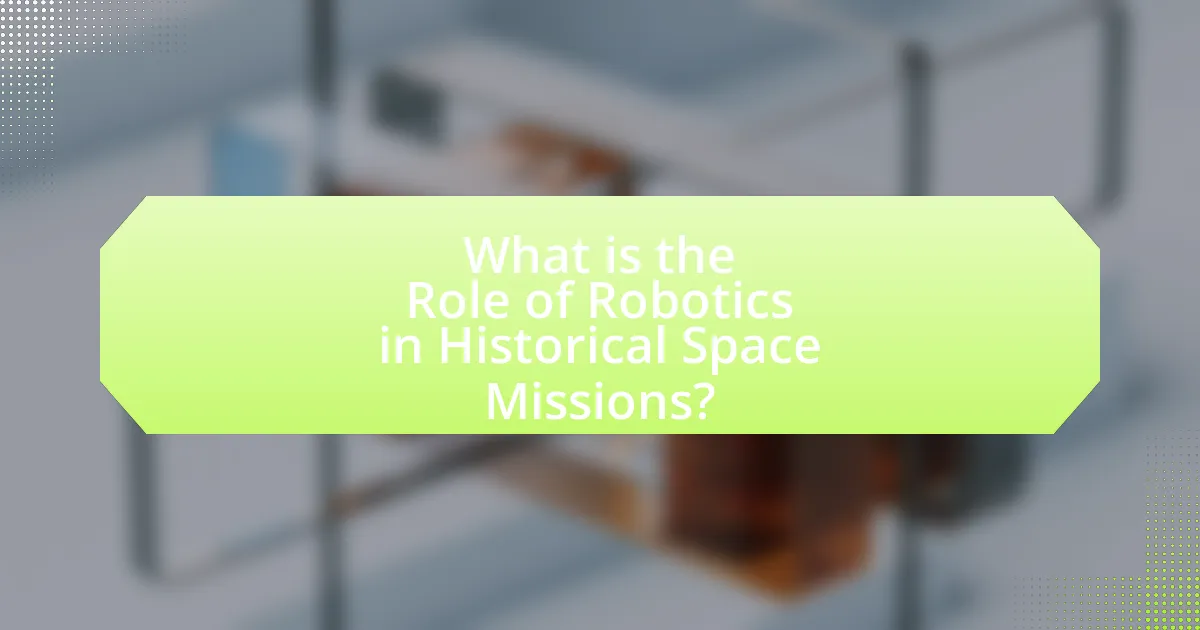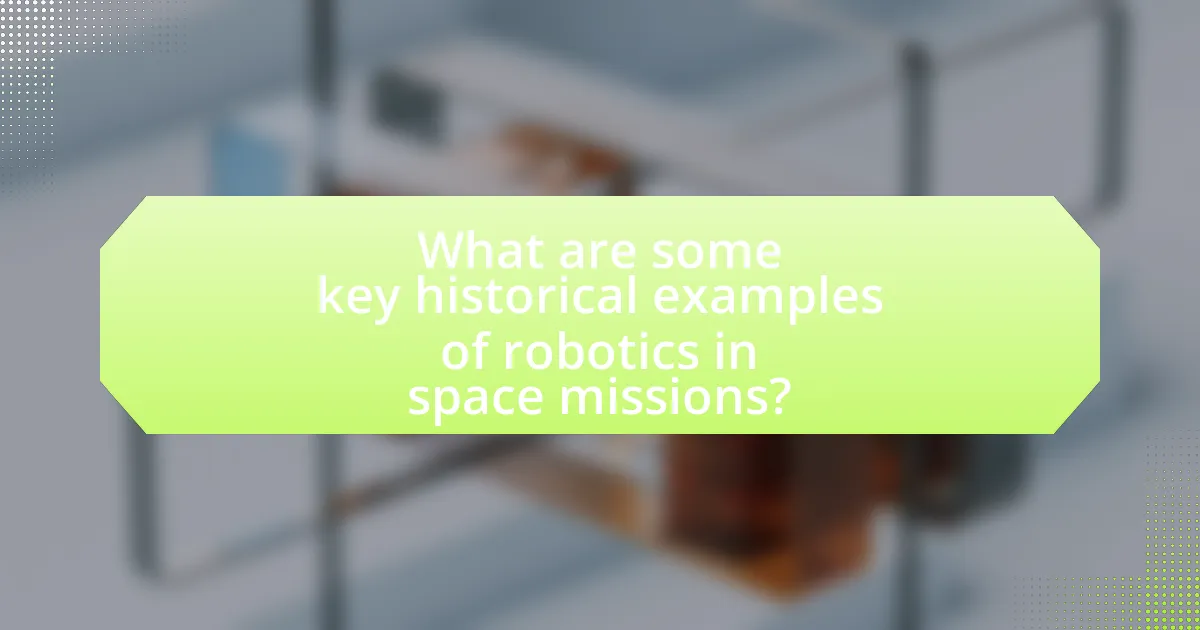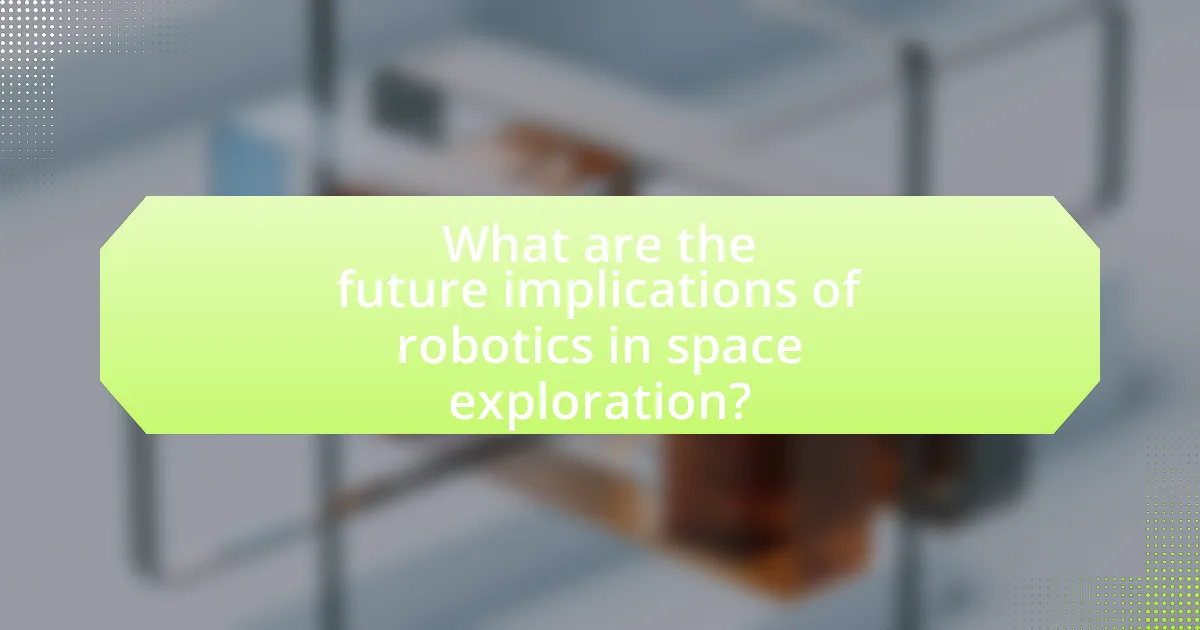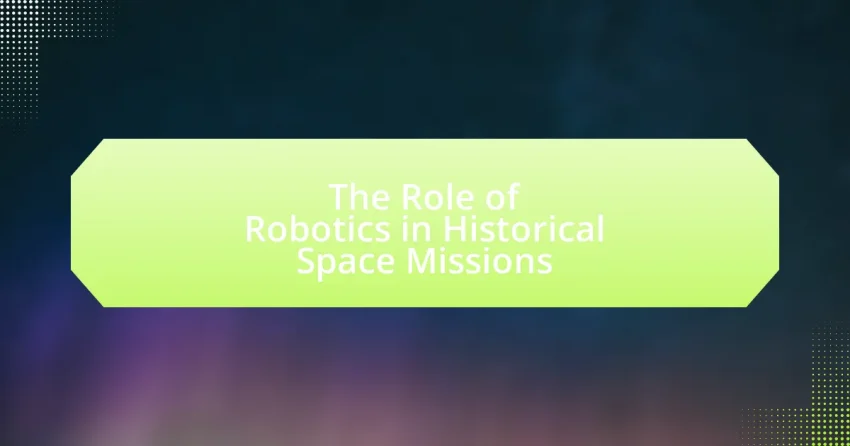The article examines the pivotal role of robotics in historical space missions, highlighting how robotic systems have facilitated exploration, maintenance, and data collection in environments inhospitable to humans. Key examples include NASA’s Mars rovers, which have conducted geological surveys and analyzed soil samples, and the robotic arms used in the Space Shuttle and International Space Station for assembly and maintenance tasks. The discussion also covers the evolution of robotic technologies, their advantages over human astronauts, and the lessons learned from past missions, emphasizing the critical contributions of robotics to advancing space exploration and enhancing mission safety and efficiency.

What is the Role of Robotics in Historical Space Missions?
Robotics played a crucial role in historical space missions by enabling tasks that were too dangerous or complex for human astronauts. For instance, the Mars rovers, such as Spirit and Opportunity, conducted extensive geological surveys and analyzed soil samples, providing invaluable data about the Martian environment. Additionally, robotic arms on the Space Shuttle and the International Space Station facilitated the assembly and maintenance of spacecraft, allowing for precise operations in microgravity. These robotic systems enhanced mission safety and efficiency, demonstrating their essential contribution to space exploration.
How have robotics been utilized in various space missions?
Robotics have been utilized in various space missions primarily for tasks such as exploration, maintenance, and data collection. For instance, NASA’s Mars rovers, including Spirit, Opportunity, and Curiosity, have autonomously navigated the Martian surface, conducted scientific experiments, and transmitted data back to Earth, significantly enhancing our understanding of the planet. Additionally, the robotic arms on the International Space Station (ISS) have been essential for assembling and maintaining the station, allowing astronauts to perform complex tasks safely from a distance. The Hubble Space Telescope also employed robotic servicing missions, where astronauts used robotic tools to repair and upgrade the telescope, extending its operational life and improving its capabilities. These examples illustrate the critical role of robotics in advancing space exploration and research.
What specific tasks have robots performed in space exploration?
Robots have performed various specific tasks in space exploration, including conducting scientific experiments, collecting samples, and operating spacecraft. For instance, the Mars rovers, such as Spirit and Opportunity, were designed to analyze soil and rock samples, providing valuable data about the Martian environment. Additionally, the Voyager spacecraft have been instrumental in gathering information about the outer planets and their moons, transmitting data back to Earth since their launch in 1977. These tasks demonstrate the critical role robots play in expanding our understanding of space and conducting missions that would be challenging or impossible for humans to perform directly.
How do robotic systems enhance mission capabilities?
Robotic systems enhance mission capabilities by increasing operational efficiency, reducing human risk, and enabling complex tasks in environments that are inhospitable to humans. For instance, robotic rovers like NASA’s Mars Curiosity have autonomously navigated the Martian surface, conducting scientific experiments and sending data back to Earth, which allows for extensive exploration without the need for human presence. This capability is supported by the fact that robotic systems can operate continuously without fatigue, perform precise maneuvers, and withstand extreme conditions, as demonstrated by the success of robotic missions such as the Voyager spacecraft, which have traveled beyond our solar system and provided invaluable data about outer planets.
Why is robotics important in the context of space exploration?
Robotics is crucial in space exploration because it enables the execution of complex tasks in environments that are inhospitable to humans. Robotic systems, such as rovers and landers, have been instrumental in missions like NASA’s Mars rovers, which have conducted extensive geological surveys and analyzed soil samples, providing invaluable data about the planet’s history and potential for life. For instance, the Mars Curiosity rover, launched in 2011, has traveled over 25 kilometers and sent back more than 700,000 images, significantly enhancing our understanding of Martian geology and climate. This capability to operate autonomously or remotely allows for the exploration of distant celestial bodies without the immediate risks associated with human presence, thereby expanding the scope and safety of space missions.
What advantages do robots offer over human astronauts in space?
Robots offer several advantages over human astronauts in space, primarily including enhanced safety, cost-effectiveness, and the ability to operate in extreme environments. Robots can perform tasks in hazardous conditions without risking human life, such as repairing satellites or exploring planetary surfaces. For instance, the Mars rovers, like Curiosity and Perseverance, have successfully conducted extensive scientific research on Mars, operating in conditions that would be perilous for humans. Additionally, robots do not require life support systems, which significantly reduces mission costs and complexity. According to NASA, robotic missions have been instrumental in gathering data and conducting experiments in space, often at a fraction of the cost of human missions.
How do robots contribute to safety and efficiency in missions?
Robots enhance safety and efficiency in missions by performing tasks that are hazardous for humans and optimizing operational processes. For instance, in space missions, robotic systems like the Mars rovers conduct geological surveys and analyze environmental conditions, reducing the risk to human astronauts. Additionally, robots can operate continuously without fatigue, allowing for extended data collection and analysis, which increases mission productivity. Historical examples include the use of the Voyager spacecraft, which provided invaluable data about the outer planets without the need for human presence, demonstrating how robotic technology can achieve complex objectives safely and efficiently.

What are some key historical examples of robotics in space missions?
Key historical examples of robotics in space missions include the Mars rovers, such as Sojourner in 1997, which was the first successful robotic rover on Mars, and the more advanced rovers Spirit and Opportunity, which operated from 2004 to 2018 and provided extensive geological data. Another significant example is the Voyager spacecraft, launched in 1977, which utilized robotic technology to explore the outer planets and continue to send data back to Earth. The Hubble Space Telescope, launched in 1990, also exemplifies robotics in space, employing robotic servicing missions to maintain and upgrade its instruments. These missions demonstrate the critical role of robotics in expanding our understanding of space and conducting scientific research beyond Earth.
What roles did robotics play in the Apollo missions?
Robotics played a crucial role in the Apollo missions primarily through the use of robotic spacecraft and systems for lunar exploration and data collection. The Lunar Module, which was part of the Apollo missions, utilized automated systems for landing on the Moon, allowing astronauts to focus on scientific tasks rather than piloting. Additionally, robotic devices such as the Lunar Roving Vehicle (LRV) enabled astronauts to traverse the lunar surface more efficiently, expanding the range of exploration and sample collection. The use of robotics in these missions facilitated the gathering of valuable scientific data, including geological samples and environmental measurements, which were essential for understanding the Moon’s composition and history.
How did robotic systems assist in lunar exploration during Apollo?
Robotic systems assisted in lunar exploration during the Apollo missions primarily through the use of robotic spacecraft and landers that conducted pre-mission reconnaissance and data collection. For instance, the Lunar Orbiter program, which consisted of five robotic spacecraft launched between 1966 and 1967, mapped the Moon’s surface and identified potential landing sites for Apollo missions. Additionally, the Surveyor program included robotic landers that successfully soft-landed on the Moon, providing critical data on the lunar surface’s composition and characteristics, which informed the design and planning of subsequent crewed missions. These robotic systems played a vital role in ensuring the safety and success of human exploration by gathering essential information before astronauts arrived.
What lessons were learned from the use of robotics in Apollo missions?
The use of robotics in the Apollo missions taught critical lessons about automation, remote operation, and the importance of redundancy in space exploration. Specifically, the Lunar Module’s robotic systems demonstrated that automated processes could effectively assist astronauts in landing and conducting experiments on the lunar surface. Additionally, the missions highlighted the necessity for robust communication systems to control robotic functions from Earth, as seen in the successful operation of the Lunar Roving Vehicle, which expanded the range of exploration. These experiences underscored the value of integrating robotics into human spaceflight, paving the way for future missions that rely on automated systems for safety and efficiency.
How did robotics evolve during the Space Shuttle program?
Robotics evolved significantly during the Space Shuttle program, primarily through the development and integration of robotic systems for tasks such as satellite deployment, maintenance, and assembly in space. The introduction of the Canadarm, a robotic arm used on the Space Shuttle, marked a pivotal advancement, enabling astronauts to manipulate payloads and perform intricate tasks outside the shuttle. Over the program’s 30-year span, from 1981 to 2011, enhancements in robotic technology included improved dexterity, automation, and remote operation capabilities, which facilitated complex missions like the assembly of the International Space Station. The successful use of robotics during these missions demonstrated their effectiveness and reliability, leading to increased reliance on robotic systems in subsequent space exploration initiatives.
What specific robotic technologies were developed for the Space Shuttle?
The specific robotic technologies developed for the Space Shuttle include the Remote Manipulator System (RMS), also known as Canadarm, and the Space Shuttle’s robotic arm, which was used for satellite deployment, servicing, and assembly tasks in space. The Canadarm was a pivotal technology that enabled astronauts to manipulate payloads and perform tasks outside the shuttle, enhancing mission capabilities. Additionally, the Orbiter’s robotic systems facilitated the capture and release of satellites, as well as the assembly of the International Space Station. These technologies were integral to the success of numerous missions, demonstrating the importance of robotics in space exploration.
How did these technologies impact mission outcomes?
Robotic technologies significantly enhanced mission outcomes in historical space missions by improving data collection, operational efficiency, and safety. For instance, the Mars rovers, such as Spirit and Opportunity, utilized advanced robotics to traverse the Martian surface, conduct geological surveys, and send back critical data, which led to the discovery of past water activity on Mars. This data was pivotal in shaping our understanding of the planet’s history and potential for life. Additionally, robotic arms on spacecraft like the Space Shuttle enabled precise manipulation of payloads, which increased mission success rates and reduced the risk to astronauts. The integration of robotics in these missions not only expanded scientific knowledge but also demonstrated the effectiveness of remote operations in challenging environments.

What are the future implications of robotics in space exploration?
The future implications of robotics in space exploration include enhanced efficiency, increased safety for human astronauts, and the ability to conduct complex tasks in extreme environments. Robotics will enable missions to distant planets and moons, such as Mars and Europa, where human presence is limited or impractical. For instance, NASA’s Perseverance rover, which landed on Mars in 2021, demonstrates how robotic systems can autonomously navigate and analyze geological samples, paving the way for future missions that may involve human colonization. Additionally, advancements in robotic technology, such as AI and machine learning, will allow for real-time decision-making and adaptability in unpredictable conditions, significantly improving mission outcomes.
How will robotics shape upcoming missions to Mars and beyond?
Robotics will significantly shape upcoming missions to Mars and beyond by enhancing exploration capabilities, improving data collection, and enabling autonomous operations. Advanced robotic systems, such as rovers and drones, will be deployed to navigate the Martian terrain, conduct scientific experiments, and gather samples with precision. For instance, NASA’s Perseverance rover, equipped with sophisticated robotic arms and instruments, is designed to analyze soil and rock samples, demonstrating the effectiveness of robotics in extraterrestrial environments. Furthermore, robotics will facilitate remote operations, reducing the need for human presence and allowing for longer missions, as seen in the Mars 2020 mission, which successfully operated autonomously for extended periods. This reliance on robotics not only increases mission efficiency but also enhances safety by minimizing risks to human astronauts.
What advancements in robotics are being developed for future missions?
Advancements in robotics for future missions include the development of autonomous systems capable of performing complex tasks without human intervention. These systems are being designed to enhance exploration capabilities on planets like Mars, where robots will conduct scientific experiments, analyze soil samples, and navigate challenging terrains. For instance, NASA’s Perseverance rover utilizes advanced AI algorithms for autonomous navigation and decision-making, allowing it to traverse the Martian landscape efficiently. Additionally, research is focused on improving robotic dexterity and manipulation, enabling robots to assemble structures or conduct repairs in space environments, as demonstrated by the European Space Agency’s work on robotic arms for the International Space Station. These advancements are crucial for increasing the efficiency and safety of future space missions.
How might robotics change our approach to extraterrestrial life exploration?
Robotics will significantly enhance our approach to extraterrestrial life exploration by enabling autonomous and precise operations in environments that are hostile or inaccessible to humans. For instance, robotic missions like NASA’s Mars rovers have successfully conducted extensive geological surveys and analyzed soil samples, providing critical data about the planet’s potential to support life. These robots are equipped with advanced sensors and analytical tools, allowing them to perform tasks such as identifying organic compounds and assessing environmental conditions without direct human intervention. This capability not only increases the efficiency of exploration but also reduces the risks associated with human space travel, as demonstrated by the success of the Curiosity rover, which has operated on Mars since 2012 and has sent back invaluable information about the planet’s habitability.
What best practices should be considered when integrating robotics into space missions?
When integrating robotics into space missions, best practices include thorough testing, robust design, and clear communication protocols. Thorough testing ensures that robotic systems can withstand the harsh conditions of space, as demonstrated by NASA’s extensive testing of the Mars rovers, which included simulations of Martian terrain and environmental conditions. Robust design focuses on creating systems that can operate autonomously and recover from failures, as seen in the success of the Voyager spacecraft, which continued to send data back to Earth long after its initial mission parameters were completed. Clear communication protocols are essential for coordinating between human operators and robotic systems, exemplified by the protocols established during the International Space Station missions, which facilitate real-time data exchange and command execution. These practices enhance mission success rates and ensure the reliability of robotic systems in space exploration.
How can mission planners effectively utilize robotic systems?
Mission planners can effectively utilize robotic systems by integrating them into mission design for tasks such as data collection, exploration, and maintenance. For instance, robotic systems like the Mars rovers have been employed to gather geological data and assess environmental conditions, which enhances mission objectives by providing critical information without risking human lives. Historical examples, such as the use of the Voyager spacecraft, demonstrate that robotic systems can operate in extreme environments, allowing for extended missions that would be impossible for human crews. These systems also enable real-time decision-making through autonomous operations, which increases efficiency and reduces the need for constant communication with Earth.
What common challenges arise when deploying robotics in space, and how can they be addressed?
Common challenges in deploying robotics in space include harsh environmental conditions, communication delays, and power limitations. Harsh conditions, such as extreme temperatures and radiation, can damage robotic components; using radiation-hardened materials and thermal insulation can mitigate this risk. Communication delays, particularly with distant missions, can hinder real-time control; implementing autonomous systems with advanced algorithms allows robots to operate independently. Power limitations, due to reliance on solar energy or limited battery life, can restrict operational time; utilizing efficient energy management systems and exploring alternative power sources, like nuclear energy, can enhance mission viability. These strategies have been validated in missions like the Mars rovers, which successfully navigated these challenges through robust design and autonomous capabilities.
